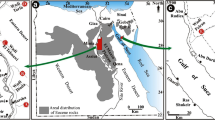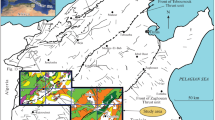Abstract
Combined subsidence and thermal 1D modelling was performed on six well-sections located in the north-western Mid-Polish Trough/Swell in the eastern part of the Central European Basin system. The modelling allowed constraining quantitatively both the Mesozoic subsidence and the magnitude of the Late Cretaceous–Paleocene inversion and erosion. The latter most probably reached 2,400 m in the Mid-Polish Swell area. The modelled Upper Cretaceous thickness did not exceed 500 m, and probably corresponded to 200–300 m in the swell area as compared with more than 2,000 m in the adjacent non-inverted part of the basin. Such Upper Cretaceous thickness pattern implies early onset of inversion processes, probably in the Late Turonian or Coniacian. Our modelling, coupled with previous results of stratigraphic and seismic studies, demonstrates that the relatively low sedimentation rates in the inverted part of the basin during the Late Cretaceous were the net result of several discrete pulses of non-deposition and/or erosion that were progressively more pronounced towards the trough axis. The last phase of inversion started in the Late Maastrichtian and was responsible for the total amount of erosion, which removed also the reduced Upper Cretaceous deposits. According to our modelling results, a Late Cretaceous heat-flow regime which is similar to the present-day conditions (about 50 mW/m2) was responsible for the observed organic maturity of the Permian-Mesozoic rocks. This conclusion does not affect the possibility of Late Carboniferous–Permian and Late Permian–Early Triassic thermal events.









Similar content being viewed by others

References
Allen PA, Allen JR (2005) Basin analysis: principles and applications, 2nd edn. Blackwell Publishing, Oxford, pp 1–560
Breitkreuz C, Kennedy A (1999) Magmatic flare-up at the Carboniferous/Permian boundary in the NE German basin revealed by SHRIMP zircon ages. Tectonophysics 302:307–326
Breitkreuz C, Kennedy A, Geißler M, Ehling BC, Kopp J, Muszyński A, Protas A, Stouge S (2007) Far Eastern Avalonia: its chronostratigraphic structure revealed by SHRIMP zircon ages from Upper Carboniferous to Lower Permian volcanic rocks (drill cores from Germany, Poland and Denmark). GSA Spec Pap 423:173–190
Dadlez R (2006) The Polish Basin—relationships between the crystalline, consolidated and sedimentary crust. Geol Q 50:43–57
Dadlez R (2003) Mesozoic thickness pattern in the Mid-Polish Trough. Geol Q 47:223–240
Dadlez R (2001) Mid-Polish Trough—geological cross-sections (1:200 000). Polish Geological Institute, Warszawa
Dadlez R. (1978) Sub-Permian rock complexes in the Koszalin–Chojnice Zone (in Polish with English summary). Geol Q 22:269–301
Dadlez R, Grad M, Guterch A (2005) Crustal structure below the Polish Basin: is it composed of proximal terranes derived from Baltica? Tectonophysics 411:111–128
Dadlez R, Jóźwiak W, Młynarski S (1997) Subsidence and inversion in the western part of Polish Basin—data from seismic velocities. Geol Q 41:197–208
Dadlez R, Leszczyński K (1999) Subsidence and the problem of incipient inversion in the Mid-Polish Trough based on thickness maps and Cretaceous lithofacies analysis—discussion (in Polish with English summary). Przegląd Geologiczny 47:625–628
Dadlez R, Marek S, Pokorski J (2000) Geological Map of Poland without Cainozoic Deposits (1:1 000 000). Polish Geological Institute, Warszawa
Dadlez R, Marek S, Pokorski J (1998) Paleogeographic atlas of epicontinental Permian and Mesozoic in Poland (1:2 500 000). Polish Geological Institute, Warszawa
Dadlez R, Narkiewicz M, Stephenson RA, Visser MTM, van Wees JD (1995) Tectonic evolution of the Mid-Polish Trough: modeling implications and significance for central European geology. Tectonophysics 252:179–195
Grabowski J, Narkiewicz M, Sobień K (2006) Thermal controls on the remagnetization of Devonian carbonate rocks in the Kielce region (Holy Cross Mts.) (in Polish with English summary). Przegląd Geologiczny 54:895–905
Gradstein FM, Ogg JG, Smith AG (2004) A geologic time scale 2004. Cambridge University Press, Cambridge, pp 3–589
Grotek I (2006) Thermal maturity of organic matter from the sedimentary cover deposits from Pomeranian part of the TESZ, Baltic Basin and adjacent area (in Polish with English summary). Prace Państwowego Instytutu Geologicznego 186:253–270
Grotek I (2005) Alteration of the coalification degree of the organic matter dispersed in the Carboniferous sediments along border of the East-European Craton in Poland (in Polish with English summary). Biuletyn Państwowego Instytutu Geologicznego 413:5–80
Guterch A, Grad M (2006) Lithospheric structure of the TESZ in Poland based on modern seismic experiments. Geol Q 50:23–32
Jaskowiak-Schoeneichowa M, Krassowska A (1988) Palaeothickness, lithofacies and palaeotectonics of the epicontinental Upper Cretaceous in Poland (in Polish with English summary). Kwartalnik Geologiczny 32:177–198
Karnkowski PH (1999) Origin and evolution of the Polish Rotliegend Basin. Polish Geol Inst Spec Pap 3:1–93
Karnkowski PH (1996) Thermal history and hydrocarbon generation in the area of Dobrzyca Structure (Western Pomerania, Poland) (in Polish with English summary). Przegląd Geologiczny 44:349–357
Karwasiecka M, Bruszewska B (1997) Gęstość powierzchniowego strumienia cieplnego Ziemi na obszarze Polski (in Polish). Centralne Archiwum Geologiczne, no. 060 21/98, Warszawa
Kiersnowski H, Buniak A (2006) Evolution of the Rotliegend Basin of northwestern Poland. Geol Q 50:119–138
Krassowska A (1997) The Upper Cretaceous. Sedimentation, paleogeography and paleotectonics. In: Marek S, Pajchlowa M (eds) The epicontinental Permian and Mesozoic in Poland (in Polish with English summary). Prace Państwowego Instytutu Geologicznego 153:386–402
Królikowski C (2006) Crustal-scale complexity of the contact zone between the Palaeozoic Platform and the East European Craton in the NW Poland. Geol Q 50:33–42
Krzywiec P (2006a) Triassic-Jurassic evolution of the Pomeranian segment of the Mid-Polish Trough—basement tectonics and subsidence patterns. Geol Q 50:139–150
Krzywiec P (2006b) Structural inversion of the Pomeranian and Kuiavian segments of the Mid-Polish Trough—lateral variations in timing and structural style. Geol Q 50:151–168
Krzywiec P (2002) Mid-Polish Trough inversion—seismic examples, main mechanisms, and its relationship to the Alpine-Carpathian collision. EGS Stephan Mueller Spec Publ Series 1:233–258
Kutek J (2001) The Polish Permo-Mesozoic Rift Basin. In: Ziegler PA, Cavazza W, Robertson AHF, Crasquin-Soleau S (eds) Peri-Tethys memoir 6: Peri-Tethyan rift/wrench Basins and passive margins. Mém Mus Natn Hist Nat 186:213–236
Kutek J, Głazek J (1972) The Holy Cross area, Central Poland, in the Alpine cycle. Acta Geol Polonica 22:603–653
Lamarche J, Scheck M, Lewerenz B (2003) Heterogeneous tectonic inversion of the Mid-Polish Trough related to crustal architecture, sedimentary patterns and structural inheritance. Tectonophysics 373:75–92
Leszczyński K (2002) Late Cretaceous inversion and salt tectonics in the Koszalin-Chojnice and Drawno-Człopa-Szamotuły zones, Pomeranian sector of the Mid-Polish Trough. Geol Q 46:347–362
Leszczyński K (2000) The Late Cretaceous sedimentation and subsidence south-west of the Kłodawa Salt Diapir, central Poland. Geol Q 44:167–174
Leszczyński K (1998) The Upper Cretaceous. In: Dadlez R, Marek S, Pokorski J (eds). Paleogeographic atlas of epicontinental Permian and Mesozoic in Poland (1:2 500 000). Polish Geological Institute, Warszawa
Littke R, Bayer U, Gajewski D (2005) Dynamics of sedimentary basins: the example of the Central European Basin system. Int J Earth Sci 94:779–981
Majorowicz JA, Cermak V, Safanda J, Krzywiec P, Wróblewska M, Guterch A, Grad M (2003) Heat flow models cross the Trans-European Suture Zone in the area of the POLONAISE’97 seismic experiment. Phys Chem Earth 28:375–391
Majorowicz J, Wróblewska M, Krzywiec P (2002) Interpretation and modeling of earth’s heat flow within the area of POLONAISE’97 seismic experiment—critical analysis (in Polish with English summary). Przegląd Geologiczny 50:1082–1091
Marek S, Pajchlowa M (1997) The epicontinental Permian and Mesozoic in Poland (in Polish with English summary). Prace Państwowego Instytutu Geologicznego 153:1–452
Marynowski L, Salamon M, Narkiewicz M (2002) Thermal maturity and depositional environments of organic matter in the post-Variscan succession of the Holy Cross Mountains. Geol Q 46:25–36
Mazur S, Scheck-Wenderoth M, Krzywiec P (2005) Different modes of the Late Cretaceous–Early tertiary inversion in the North German and Polish basins. Int J Earth Sci 94:782–798
Menning M, Hendrich A (2002) Stratigraphische Tabelle von Deutschland 2002. Deutsche Stratigraphische Kommision, GeoForschungsZentrum, Potsdam
Narkiewicz M, Poprawa P, Lipiec M, Matyja H, Miłaczewski L (1998) Palaeogeographic and tectonic setting and the Devonian–Carboniferous subsidence development of the Pomerania and Radom-Lublin areas (TESZ, Poland) (in Polish with English summary). Prace Państwowego Instytutu Geologicznego 165:31–49
Petmecky S, Meier L, Reisser H, Littke R (1999) High thermal maturity in the Lower Saxony Basin: intrusion or deep burial? Tectonophysics 304:317–344
Piwocki M (2004) Paleogen. In: Peryt T, Piwocki M (eds) Budowa geologiczna Polski Tom I, Stratygrafia, cz. 3a, Kenozoik, Paleogen i neogen (in Polish). Państwowy Instytut Geologiczny, Warszawa, pp 22–71
Scheck-Wenderoth M, Lamarche J (2005) Crustal memory and basin evolution in the Central European Basin system—new insights from a 3D structural model. Tectonophysics 397:143–165
Senglaub Y, Littke R, Brix MR (2006) Numerical modelling of burial and temperature history as an approach for an alternative interpretation of the Bramsche anomaly, Lower Saxony Basin. Int J Earth Sci 95:204–224
Stefaniuk M, Baranowski P, Czopek B, Maćkowski T (1996) Study of compaction in the Pomeranian Anticlinorium area. Oil Gas News Poland 6:150–162
Stephenson RA, Narkiewicz M, Dadlez R, van Wees JD, Andriessen P (2003) Tectonic subsidence modeling of the Polish Basin in the light of new data on crustal structure and magnitude of inversion. Sediment Geol 156:56–70
Sweeney JJ, Burnham AK (1990) Evaluation of a simple model of vitrinite reflectance based on chemical kinetics. AAPG Bull 74:1559–1570
Świdrowska J, Hakenberg M (1999a) Subsidence and the problem of incipient inversion in the Mid-Polish Trough based on thickness maps and Cretaceous lithofacies analysis (in Polish with English summary). Przegląd Geologiczny 47:61–68
Świdrowska J, Hakenberg M (1999b) Subsidence and the problem of incipient inversion in the Mid-Polish Trough based on thickness maps and Cretaceous lithofacies analysis—reply (in Polish with English summary). Przegląd Geologiczny 47:628–634
Taylor GH, Teichmüller M, Davies A, Diessel CFK, Littke R, Robert P (1998) Organic petrology. Gebrüder Bornträger, Berlin, pp 1–704
Wagner R (1994) Stratigraphy and evolution of the Zechstein Basin in the Polish Lowland (in Polish with English summary). Prace Państwowego Instytutu Geologicznego 146:1–71
van Wees JD, Stephenson RA, Ziegler PA, Bayer U, McCann T, Dadlez R, Gaupp R, Narkiewicz M, Bitzer F, Scheck M (2000) On the origin of the Southern Permian Basin, Central Europe. Mar Petroleum Geol 17:43–59
Welte DH, Horsfield B, Baker DR (1997) Petroleum and basin evolution: Insights from petroleum geochemistry, geology and basin modeling. Springer, Heidelberg, pp 1–535
Wygrala (1989) Integrated study of an oil field in the southern Po Basin, northern Italy. Berichte der Forschnugszentrum Jülich 2313:1–217
Ziegler PA (1990) Geological Atlas of Western and Central Europe. 2nd and completely revised edition. Shell Internationale Petroleum Maatschappij B.V., Den Haag
Ziegler PA, Cloetingh S, van Wees JD (1995) Dynamics of intra-plate compressional deformation: the Alpine foreland and other examples. Tectonophysics 252:7–59
Żelichowski AM (1987) Karbon. Ogólna charakterystyka stratygraficzna. In: Raczyńska A (eds) Budowa geologiczna wału pomorskiego i jego podłoża (in Polish). Prace Instytutu Geologicznego 119:46–51
Acknowledgments
The project runs within the DFG (German Science Foundation) priority programme 1135 “Dynamics of sedimentary systems under varying stress regimes: the example of the Central European Basin System” (grant no. Li 618/15). We are grateful to Prof. Ryszard Dadlez who shared with us his regional knowledge on the Polish Lowlands geology. Izabella Grotek is thanked very much for providing necessary vitrinite reflectance data. We would also like to express our thanks to Marta Wróblewska for providing updated data on present-day thermal field. Magdalena Scheck-Wenderoth and Stanisław Mazur are appreciated for their comments and suggestions, which helped to improve the manuscript.
Author information
Authors and Affiliations
Corresponding author
Rights and permissions
About this article
Cite this article
Resak, M., Narkiewicz, M. & Littke, R. New basin modelling results from the Polish part of the Central European Basin system: implications for the Late Cretaceous–Early Paleogene structural inversion. Int J Earth Sci (Geol Rundsch) 97, 955–972 (2008). https://doi.org/10.1007/s00531-007-0246-3
Received:
Accepted:
Published:
Issue Date:
DOI: https://doi.org/10.1007/s00531-007-0246-3



